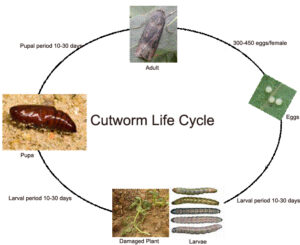Cutworms are common nocturnal nibblers that can be found in gardens across North America. These caterpillar-like larvae can cause damage to your plants, but understanding their behavior and implementing sustainable management techniques can help you coexist with them in your garden.
Is it Good or Bad to Have Cutworms in Your Garden?
While cutworms are often viewed as pests due to their plant-eating habits, they also play a role in the ecosystem. As part of the natural food chain, they provide food for various predators like birds, beetles, and beneficial insects. However, their presence in large numbers can be detrimental to your plants, especially young seedlings.
Identifying Cutworms:
- Appearance: They are plump, smooth-skinned caterpillars with various colors ranging from green to brown or gray. They have a distinct curved shape when at rest.
- Size: They can range from 1/2 to 2 inches in length, depending on the species and stage of development.
- Behavior: They are nocturnal, feeding primarily at night. During the day, they hide in the soil or debris near the base of plants.
The Lifecycle of Cutworms:
- Egg Stage: Adult moths lay eggs in the soil or on plant leaves.
- Larval Stage (Cutworms): This is the feeding stage. Cutworms emerge from eggs and start feeding on plants.
- Pupal Stage: After a period of feeding, they pupate in the soil, where they undergo metamorphosis into adult moths.
- Adult Stage: Adult moths emerge from pupae, mate, and lay eggs, completing the cycle.
What They Like to Eat:
They are not picky eaters and will feed on a variety of plants. They have a preference for young, tender seedlings, but can also target older plants.
Common targets include:
- Tomato seedlings
- Cabbage
- Lettuce
- Beans
- Peppers
- Carrots
How to Managing in a Sustainable Way:
- Handpicking: Check your plants at night with a flashlight and handpick cutworms. Dispose of them by dropping them into a bucket of soapy water.
- Beneficial Insects: Encourage natural predators like ground beetles, parasitic wasps, and birds that feed on cutworms.
- Collars and Barriers: Use physical barriers like cardboard collars or aluminum foil wrapped around the base of plants to deter cutworms from reaching them.
- Beneficial Nematodes: Apply beneficial nematodes to the soil. They are natural predators of cutworm larvae.
- Companion Planting: Planting repellent plants like marigolds or nasturtiums near susceptible crops can help deter cutworms.
- Crop Rotation: Avoid planting the same crops in the same spot each year, as this can disrupt the cutworm’s lifecycle.
In conclusion, while cutworms can be detrimental to your garden, they also serve a role in the ecosystem. By implementing sustainable management techniques, you can strike a balance that allows both your plants and cutworms to thrive in your garden.





